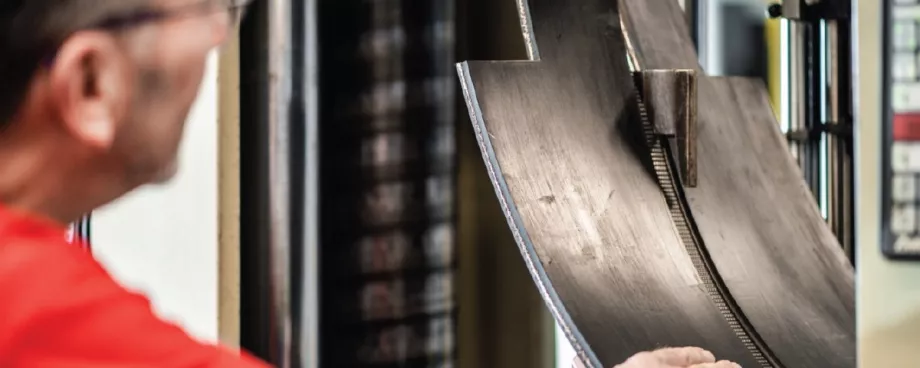Oil Resistance
When oil penetrates rubber it causes it to swell and distort. This results in serious tracking and steering problems as well as premature wear. The oils, fats and greases that have these damaging effects can be divided into two distinct sources – mineral and vegetable/animal. There are two recognised test methods, both of which involve almost identical test procedures. These are ISO 1817 (2015) and the comparable, slightly less elaborate but equally tough American ASTM ‘D’ 1460.
Even some of the biggest manufacturers of belting in the world use the DIN reference number 22102 G when referring to oil resistant belting. This can be very misleading because the letter ‘G’ is simply used to denote oil (or grease) resistant belting. The fact is that DIN 22101 G does not actually contain any requirements, test methods or limits specific to oil resistant belting. This is a classic example of how the practice of indicating a test method reference number is designed to provide reassurance to the buyer but in reality is meaningless in terms of actual performance.
Test Methods
The ISO 1817 and ASTM ‘D’ 1460 test methods are both used to measure the effect of oil (and other liquids and chemicals) on vulcanised rubber. Samples of rubber (eg. 100mm X 1.6mm X 2mm strips for the ASTM test) are fully immersed in the relevant test liquid for a specific period of time. The duration of immersion and the temperature at which the liquid and sample are kept can be varied but the most common is either 3 or 7 days at ambient or 70°C.

The ambient temperature of the environment is controlled within specific guidelines. Changes in the geometry and dimensions of the specimen caused by absorption are then measured when the samples are removed.
What to watch for: Although there are no actual performance standards in existence, it is still important to look for actual references to the test methods used by the manufacturer/supplier. During my research I found it quite disturbing to note that only one manufacturer (Dunlop again I have to say) that makes any mention whatsoever concerning the actual test methods used to determine the oil resistance qualities of their belts.
Extreme Cold Resistance
When the ambient temperature falls below -0°C rubber begins to lose its elasticity. As the temperature falls, the rubber continues to lose flexibility and its ability to resist abrasion, impact and cutting. Eventually the belt is unable to trough and pass around pulleys and the belt covers and the rubber in the carcass begins to crack. Ultimately, the belt will break because frozen rubber becomes as brittle as glass.
Testing for Cold Resistance

There are no current internationally recognised test methods for specifically determining a conveyor belt’s ability to function in extremely cold conditions. Laboratory testing involves the use of a liquid nitrogen freezing cabinet to test samples at extreme low temperatures.
The elastic modulus of samples of rubber belts are first measured at an ambient temperature of 20°C. The samples are then placed inside the cabinet. The temperature in the cabinet is then gradually reduced by stages of 5°C. The elastic modulus is measured at each stage to determine when the decrease in flexibility of the rubber becomes too great, thereby identifying its lowest permissible ambient temperature.
What to watch for: Where there is a risk of extremely low temperatures always ask for confirmation of the minimum operating temperature. Abrasion resistant belts can typically withstand -30 to – 40°C. Other cover qualities (such as oil or fire) are usually only able to withstand a minimum temperature of -20°C. For temperatures lower than this, conveyors need to be fitted with belts especially designed to withstand extreme cold.
Fire Resistant Belting
Because fire safety is such an important issue there are numerous safety classifications and international standards for which there are many different tests used to measure the self-extinguishing properties of conveyor belts. Test methods and performance standards vary enormously depending on whether a belt is for use above or below ground. For the purposes of this paper I will focus purely on the requirements for belts being used above ground. The reader is recommended to seek more detailed guidance if at all unsure of what level of fire resistance they need.
Basic Testing
The basis of most tests for belting used in normal industrial applications is EN/ISO 340. This standard makes the distinction between fire resistance with covers (K) and fire resistance with or without covers (S). The relevance of “with or without covers” is that wear reduces the amount of fire resistant rubber that protects the flammable carcass. Although no longer used in the current EN ISO 340, the market still commonly refers to grades ‘K’ for testing with covers and ‘S’ for testing with and without covers. This originates from DIN 22103 that was used as the basis during the creation of EN ISO 340.

EN/ISO 340 tests involve exposing 6 individual samples of belt to a naked flame causing them to burn. The source of the flame is then removed. A current of air is then applied to the test piece for a specified time after the removal of the flame. The time it takes for the belt sample to self-extinguish after the flame has been removed is then measured. The duration of continued burning (visible flame) should be less than 15 seconds for each sample with a maximum cumulative duration of 45 seconds for each group of six test samples. This determines how fire can be carried along a moving belt.
What to watch for: Even if a manufacturer states that their fire resistant belt has passed the ISO 340 test, the buyer should still exercise caution. A blazing conveyor belt can easily spread fire more than 40 meters in 15 seconds. If you are at all unsure of what level of fire resistance you need then it is recommended to seek more detailed guidance.














